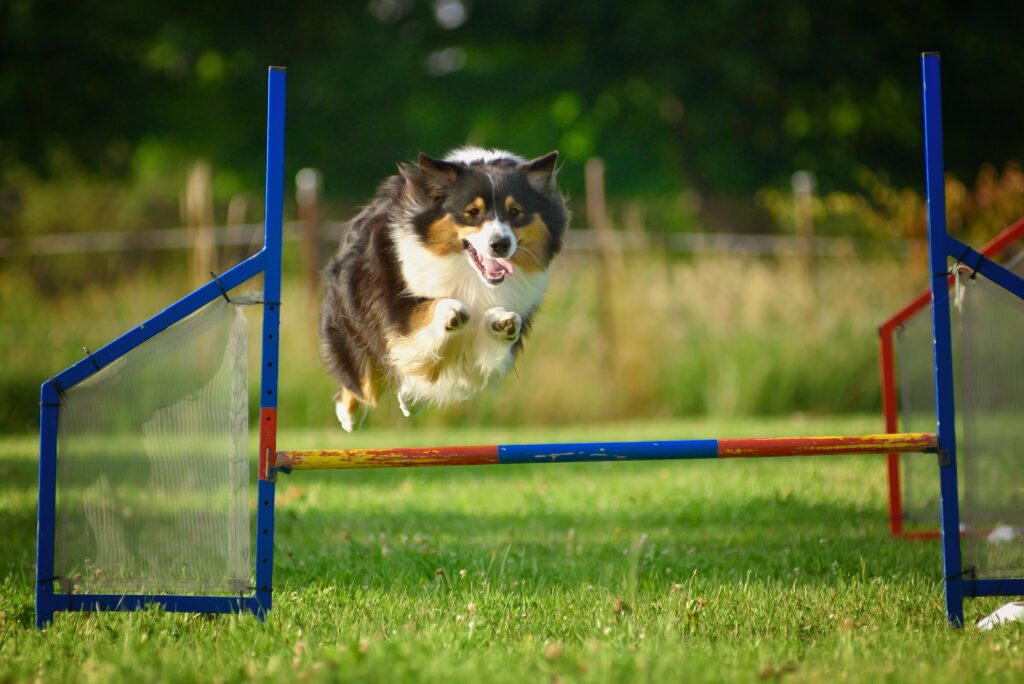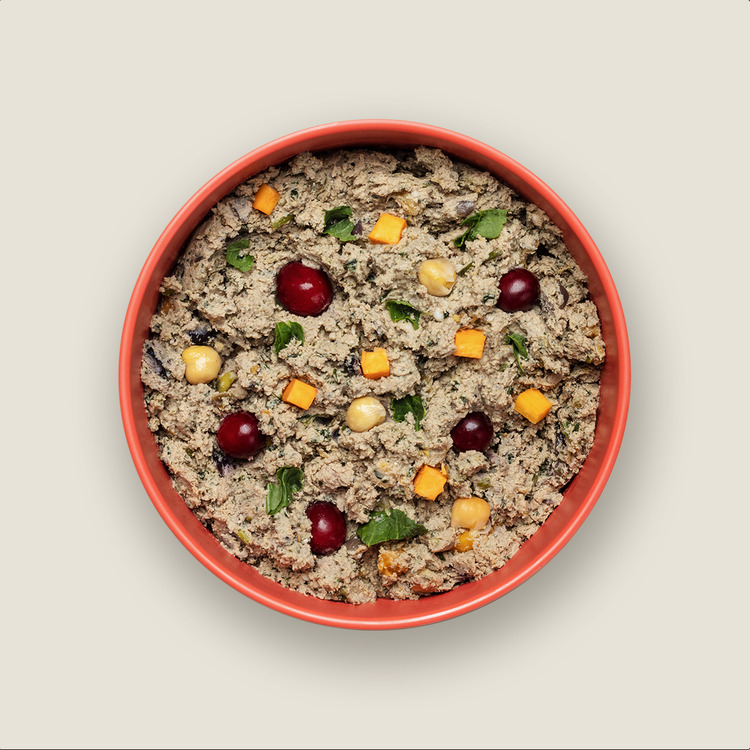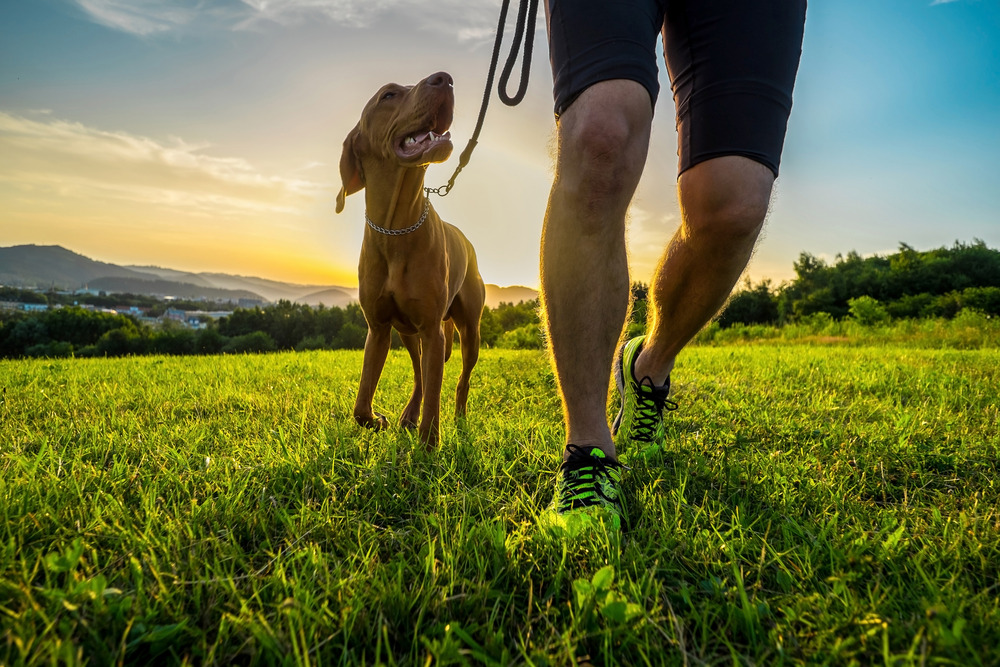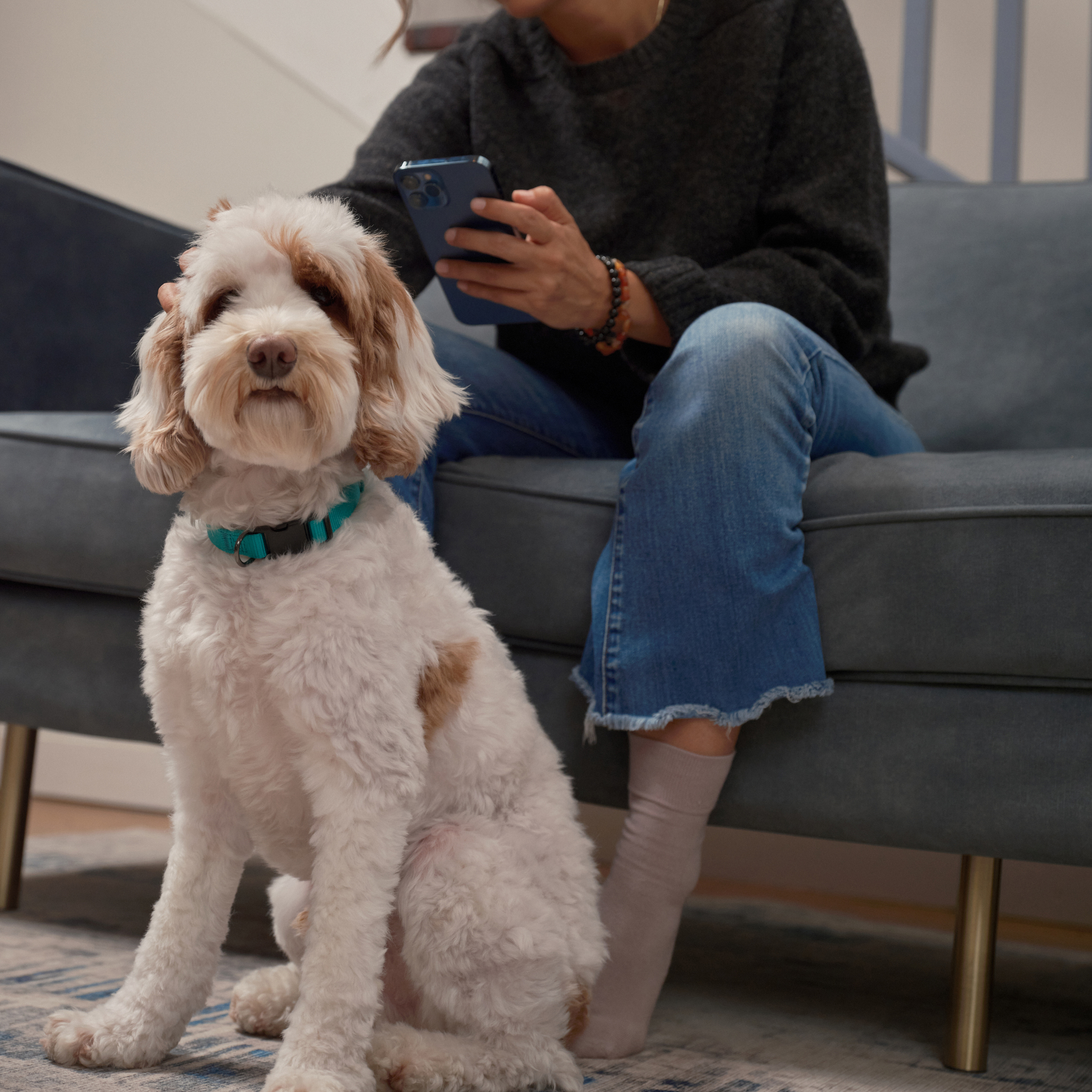Hey Ollie blog readers! We’re offering you an exclusive 60% OFF your starter box! Try now!
Do you know your dog’s ideal body shape? You should be able to feel your dog’s ribs easily, and he or she should have a waist visible at the end of the ribcage. When you look down on your furry friend, you should see an hourglass shape. This is the ideal. But obesity prevention isn’t the only reason dogs need exercise. Maintaining a healthy body condition is key to preventing a variety of health issues.
Dogs need exercise for many reasons. First, they crave it. Second, dogs need both mental and physical stimulation to keep them not only healthy but also content. Third, exercise helps stave off certain diseases like diabetes.
Just like with humans, exercising the body and mind helps to minimize stress, anxiety, and undesirable, even destructive behaviors. Dogs often get into things—like the trash—because they aren’t getting enough environmental enrichment.
At What Age Should You Start Exercising Your Dog?
Acceptable durations for leash walks and the speed and terrain walked vary with age and abilities.
Puppy Age Appropriate Exercise
Puppies with growing bones (and open growth plates) are susceptible to trauma with very high intensity exercise. This includes high intensity and long duration running, jumping, or other repetitive forceful activities.
Never force exercise. Let the dog set the pace. Generally, it is recommended that puppies simply partake in low-impact exercises such as walking or light playful running that will stimulate good bone and muscle development without taxing the system. Keep in mind that you have to be your pooch’s advocate. Most puppies will run or play as long as you will. They do not have the common sense to say, “Hey, I’m tired. I should stop so I don’t hurt myself.”
Ideally, wait until about 12-15 months of age, when growth plates are closed and sufficient skeletal growth has occurred, before any high intensity exercise. Smaller breeds reach maturity faster than large or giant breeds. Speak with your veterinarian about your specific pet.
Puppy-play and playing with another (properly vaccinated) puppy helps with socialization. However, it is ideal to wait until your dog’s growth plates have closed before starting with agility jumping or long-distance running activities. Avoid luring or significant turning or leg rotation activities where the weight is only on one leg until fully mature. Since some breeds reach skeletal maturity early and others later, most veterinarians suggest 12-18 months or older as a safe bet before undertaking significant exercise.
Adult Age Appropriate Exercise
Ensure your pet is healthy and your veterinarian has cleared the dog for the type and duration of the ‘workout’ you want to pursue.

Types of Exercise to Consider for your Dog
First and foremost, bad weather provides no excuse for failing to exercise your dog!
Consider the following activities:
- Leash walking (or jogging or running) – Make sure you set yourself up for success. Ensure your dog understands proper leash etiquette. This includes loose leash walking, not pulling toward other people or dogs, and ensuring they are comfortable running on a leash.
- Consider appropriate leashes and collars
- Consider fear-free reputable harnesses such as the Freedom No Pull Harness, Walk Your Dog with Love, or head leads such as the Gentle Leader Head Collar.
- What you choose to use depends on your dog’s size, age, activity level, and needs.
- Talk with your veterinarian if you have questions.
- Agility class
- Swimming
- A game of hide-and-seek
- Go to a park – Walk the track or in a safe, fenced-in area, play ball.
- Scent work – Sniffing and investigating the environment allows your pet to engage their sense of smell and evaluate their surroundings.
- Stair climbing – Who says you have to feed your dog in a bowl? Spread kibble on various steps or hide it throughout the house and have your dog go find the food. It can keep your pet fit and, on rainy days, still provide exercise.
- Game of fetch– That is, if your dog knows how!
- Training – Positive reinforcement methods such as cooperative care training and clicker training can provide mental stimulation for your dog. It isn’t just about learning tricks but also minimizing the anxiety associated with husbandry needs such as nail trims, physical exams, and more. Nothing beats the happy wagging tail and play bows a dog gives when they want to train! Training together with your dog can help strengthen your bond. It requires patience, but the reward is worth it!
Just letting your dog out in the fenced-in backyard doesn’t constitute exercise. Sure, a dog may run around for a few minutes, and some may get sufficient exercise for brief periods, chasing squirrels or scenting around the property. But it is not sustained aerobic activity. While it provides mental stimulation, it cannot be assumed to provide sufficient calorie-burning exercise.
For any activity you want to try, always make sure to acclimate your pet over time. Don’t throw your dog into a pool and assume the dog can swim. Gradually increase exposure, duration, time, and intensity of physical activity. Monitor your pet for signs of pain, anxiety, or resistance and if noted, back off, slow down, or change gears.
Exercising your Dog with Underlying Health Conditions
Most medical conditions still allow for some activity. Injuries or broken bones and slipped aka herniated discs in the spine may require periods of inactivity. However, even dogs with the need for restricted physical activity still need mental stimulation.
Exercising Your Arthritic Dog
Animals with arthritis need structured exercise to maintain bone strength and preserve muscle definition and function. Failing to exercise dogs with arthritis only speeds the disease process, increases pain, and decreases the quality of life. Some jerky “start-and-stop” activities such as catching frisbees or playing high-intensity fetch should, however, be avoided.
If you have a dog with arthritis, do not start an exercise program without speaking to your veterinarian. They can discuss proper pain management, weight management, and other factors to ensure that your pet gets appropriate, safe exercise without worsening arthritis.

The Dos and Don’ts of Dog Exercise
Dogs of all ages need exercise, but ensure it is appropriate for your pet’s age, breed, size, weight, and underlying medical conditions.
- Do not partake in high intensity training, running, or jumping until your dog is fully grown (12-15 months depending on size/breed).3
- Do not exercise your pet in times of extreme weather conditions. If it is too hot outside for you, imagine how hot it is for your pet. Dogs cannot cool off as effectively as people. The same goes for the cold. They don’t wear shoes, coats, or gloves.
- Do not push your pet to exercise more because you want to go farther. If your dog is noticeably limping, struggling to walk, stopping, and laying down or resisting going further, stop the activity and consider 24-48 hours of rest.
- Before starting any exercise program, do make sure your dog has a complete check-up with your veterinarian.
- Do start slowly with any activity. Build up duration, speed, and intensity over time. You wouldn’t just suddenly run a marathon without training—do not make your dog do the same thing.
Include Environmental Enrichment
Environmental enrichment consists of physical exercise to prevent obesity and maintain strong bones and muscles. It includes mental activities to ensure healthy brain function and avoid boredom.
Some breeds need more physical activity while others need more mental challenges, but many need a combination of both. It isn’t just a matter of what type of exercise but also how much and how often. It depends on the breed, age, the physical and mental ability of the dog, and what is available to the dog and owner.
Recommendations for exercise in dogs made by veterinarians, when feasible, are based on scientific studies. However, few exist encompassing different types of exercise, save walking. Still, recommendations by veterinary specialists arise from evidence-based medicine as well as an understanding of the physiology of the species.
Other Tips for a Healthy Pup
Remember, your pet needs an excellent quality pet food, well-balanced and properly proportioned. Your dog does not require you to show love with people food and tons of treats. Show your 4-legged friend your love by giving them the exercise and mental stimulation they need. Engage with them. Enjoy your time with them. Allow them time to sniff their world and achieve their ideal body condition through a variety of activities. This will ensure a happy and healthy pet and, in turn, a healthy human-animal bond.


Don’t forget your dog needs high quality food too!
Get 50% of your first box of Ollie’s fresh
delivered meals today!
References:
- 1. The Ohio State University’s Indoor Pet Initiative. Environmental Enrichment. The Ohio State University’s Indoor Pet Initiative: Environmental Enrichment. Accessed November 29, 2021
- 2. Garvey M, Stella J, Croney C. Implementing Environmental Enrichment for Dogs. Published online 2016
- 3. Millis D. What is the Logic Behind Not Exercising Puppies Until the Growth Plates are Closed? MyLameDog.com. Published December 29, 2019. Accessed December 1, 2021
- 4. Weir M, Downing R. Healthy Exercise for Dogs. VCA Know Your Pet. Published 2021. Accessed November 29, 2021
Tagged As:

The nutrition your dog needs,
the food they want.

Enjoying our articles? Subscribe our Newsletters and get new articles directly to your inbox
You might also like
18 August 2025
9 MINS READ
Nourish Skin from Within: Fresh Dog Diet Benefits
If your dog is constantly scratching, licking their paws, or has a dull, flaky coat, it’s not just frustrating—it could be a sign that something’s off in their diet. Skin and coat issues are som…
by Ollie Pets
12 August 2025
5 MINS READ
Top 8 Allergens Hiding in Your Dog’s Bowl
As pup parents, we never want to see our dogs uncomfortable. When it comes to itching, swelling, and upset stomachs, the culprit may be in their bowl. Understanding the most common allergens and t…
by Ollie Pets
11 August 2025
5 MINS READ
Not all Processing Is Equal: What’s Really in Your Pet’s Bowl?
As pet parents, we know how important it is that our dogs live long, healthy, and happy lives. This is why at Ollie, we focus so much on what goes into their bowls. But did you know there may be s…







